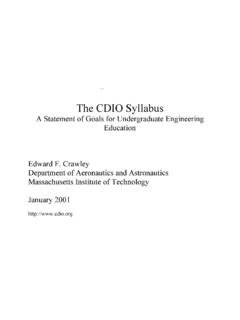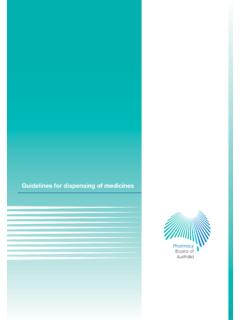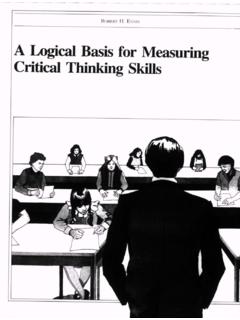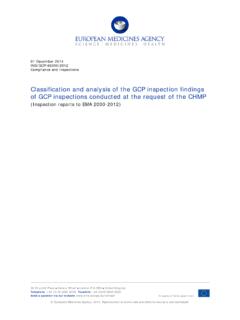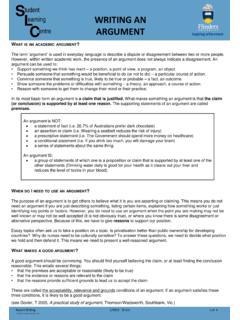Transcription of A Critical Thinking Model for Engineering - CDIO
1 1 2nd International CDIO Conference Linkoping University Linkoping, Sweden 13 to 14 June 2006 A Critical Thinking Model for Engineering R. J. Niewoehner Aerospace Engineering Department, United States Naval Academy, Annapolis, MD, USA ABSTRACT Richard Paul s Model for Critical Thinking is adapted to the challenge of Engineering education. The Model is briefly described and exemplified by questions asked by engineers in practice. The paper concludes with exercises suitable for the undergraduate and graduate Engineering program. INTRODUCTION The analysis and evaluation of our Thinking as engineers requires a vocabulary of Thinking and reasoning.
2 The intellect requires a voice. Richard Paul and Linda Elder, from the Foundation for Critical Thinking , have proposed a Critical Thinking Model documented in various sources ([1], [2] and [3]), including over a dozen Thinkers' Guides that apply this Model to diverse disciplines ( [4]). Engineers and scientists are quite comfortable working within the context of conceptual models. We employ thermodynamic models, electrical models, mathematical models, computer models or even physical models fashioned from wood or clay. Here we apply a Model to the way in which we think, an architecture whose purpose is aiding the analysis and evaluation of thought, that we might improve our thought.
3 A new thinkers' guide, Engineering Reasoning [5], applies this Model to the Engineering enterprise. This paper introduces this Thinkers' Guide as a tool for Engineering educators and students, summarizing its content and suggesting several exercises for its use in support of Engineering course and project work. The guide follows Paul's Model , providing a framework for analyzing and evaluating Engineering reports, designs, graphics, and entire disciplines. It articulates the questions that exemplify maturing Engineering reasoning. Several examples are provided of both excellence and disaster in Engineering reasoning. The Model is also applied to areas which touch Engineering such as creativity, craftsmanship, and ethics.
4 THE PROBLEM Elder [6] cites a series of studies of higher education indicating that college faculty almost unanimously insist that the promotion of Critical Thinking ranks among the primary goals of their work. Lamentably, that same body of research indicates that few college professors can articulate a substantive understanding of Critical Thinking , and few can identify the elements of their teaching that specifically develop Critical Thinking . Reference [6] appeals for the development of a substantive view of Critical Thinking both within and across college faculties. 2 THE CDIO SYLLABUS AND Critical Thinking The CDIO consortium has developed a comprehensive syllabus for an Engineering education, ratified by diverse international industry and academic leaders.
5 The syllabus articulates a diverse range of learning objectives, many of which explicitly employ the language of Critical Thinking or implicitly touch upon the Thinking capabilities of our students. Each of the below skills are cited by the syllabus as objectives in the lives of the undergraduate Engineering student (numbers in parentheses refer each item s location with the CDIO syllabus) Engineering Affective Dimensions exercising independent thought and judgment ( ) exercising reciprocity ( ) welcoming ingenuity and innovation ( , ) recognizing diverse stakeholder points of view ( , ) suspending judgment ( ) developing insight into egocentrism and sociocentrism ( ) Cognitive Dimensions.
6 Engineering Macro-Abilities selecting Critical questions to be answered ( ) clarifying technical issues and claims ( ) clarifying technological ideas ( , , ) developing criteria for technical evaluation ( ) evaluating scientific/ Engineering authorities ( ) raising and pursuing root questions( ) evaluating technical arguments ( ) generating and assessing solutions to Engineering problems ( ) identifying and clarifying relevant points of view ( ) engaging in Socratic discussion and dialectical Thinking on Engineering issues avoiding oversimplification of issues developing Engineering perspective ( ) Cognitive Dimensions: Engineering Micro-Skills evaluating data ( ) analyzing assumptions ( ) identifying and applying appropriate models ( ) explaining generalizations ( ) questioning incomplete or ambiguous information ( ) analyzing essential results of solutions and test data ( ) reconciling discrepancies in results ( ) making plausible Engineering inferences ( ) supplying appropriate evidence for a design conclusion ( ) recognizing contradictions recognizing technical, legal/regulatory, economic, environmental, and safety implications and consequences ( )
7 Distinguishing facts from Engineering principles, values, and ideas A Critical Thinking Model To address Elder s observation above, the analysis and evaluation of our Thinking as engineers requires a vocabulary of Thinking and reasoning. The intellect requires a voice. The Model that follows is not unique to Engineering ; indeed, its real power is its flexibility in adapting to any domain of life and thought. Other Thinkers' Guides apply this Model to other 3 disciplines. Engineers and scientists are quite comfortable working within the context of conceptual models.
8 We employ thermodynamic models, electrical models, mathematical models, computer models or even physical models fashioned from wood or clay. Here we apply a Model of the way in which we think, an architecture whose purpose aides the analysis and evaluation of thought, that we might improve our thought. The Model depicted in Figure 1 provides an overview of Paul s Model , which the guide develops, working from the base of the diagram up. The goal is the mature Engineering thinker, and so that endpoint is described first with a brief discussion of the intellectual virtues as might be expressed in the practice of Engineering . Figure 1: Richard Paul s Critical Thinking Subsequently, the eight elements of thought are introduced.
9 These are the tools for the analysis of Thinking in oneself and others. These elements are then exemplified and applied to analyzing texts, articles, reports, and entire Engineering disciplines. Next the intellectual standards are introduced and exemplified. These constitute the thinker's evaluation tools. The guide weaves the standards together with the elements in several formats to demonstrate application of these evaluation standards to our analysis products. Finally, this paper outlines exercises which can be used in the context of Engineering studies. INTELLECTUAL TRAITS ESSENTIAL TO Engineering REASONING The engineer does not work in isolation, but in the context of enterprises, cultures and communities, each of which represents divergent interests and perspectives.
10 Furthermore, 1 Adapted from ref [4], pg 24. Intellectual Traits/Virtues The Elements of Thought Essential Intellectual Standards Clarity Precision Accuracy Significance Relevance Completeness Logical Validity Fairness Breadth Depth must be applied to to develop Purpose Question at Hand Point of View Assumptions Data/Information Concepts Inferences/Conclusions Implications Intellectual Humility Intellectual Perseverance Intellectual Autonomy Confidence in Reason



